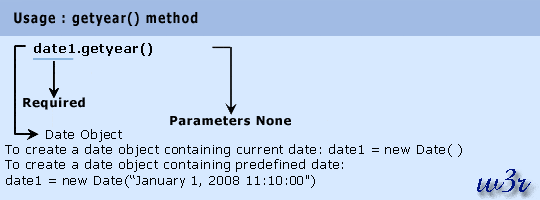JavaScript getYear() Method: Date Object
Description
The getYear() method is used to get the year of a given date according to local time.
The getYear() method returns the year minus 1900; thus:
* For years above 2000, the value returned by getYear() is 100 or greater. For example, if the year is 2009, getYear() returns 109.
* For years between and including 1900 and 1999, the value returned by getYear() is between 0 and 99. For example, if the year is 1976, getYear() returns 76.
* For years less than 1900 or greater than 1999, the value returned by getYear() is less than 0. For example, if the year is 1800, getYear() returns -100.
For years before and after 2000, you should use Date.getFullYear() instead of getYear() so that the year is specified in full.
Version
Implemented in JavaScript 1.3
Syntax
getYear()

Example:
In the following web document getYear() method returns the current year according to local time.
<!DOCTYPE html PUBLIC "-//W3C//DTD XHTML 1.0 Transitional//EN"
"http://www.w3.org/TR/xhtml1/DTD/xhtml1-transitional.dtd">
<html xmlns="http://www.w3.org/1999/xhtml" xml:lang="en" lang="en">
<head>
<meta http-equiv="content-type" content="text/html; charset=iso-8859-1" />
<title>JavaScript date object - getYear() method example</title>
</head>
<body>
<h1 style="color: red">JavaScript date object : getYear() method</h1>
<hr />
<script type="text/javascript">
//This is done to make the following JavaScript code compatible to XHTML. <![CDATA[
current_date = new Date()
cmm = current_date.getYear()
document.write(cmm)
//]]>
</script>
</body>
</html>
View the example in the browser
Supported Browser
| Internet Explorer 7 | Firefox 3.6 | Google Chrome 7 | Safari 5.0.1 | Opera 10 |
| Yes | Yes | Yes | Yes | Yes |
See also:
JavaScript Core objects, methods, properties.
Previous: JavaScript parse() Method: Date Object
Next: JavaScript getYear() Method: Date Object
Test your Programming skills with w3resource's quiz.
